ASUS' N82Jv: Jack-Of-All-Trades
by Jarred Walton on September 11, 2010 11:10 PM ESTASUS N82Jv-X2 High Quality
So just how far can we push the GT 335M before it hits the wall? Our Medium settings are a good blend of quality and performance, but move up to High settings and performance starts to plummet—especially if you want to run at higher resolutions. In that regard, the 768p LCDs that are everywhere these days are a benefit. Then again, you can always run a 900p or 1080p at a lower resolution if you need to, but you'll never get a 1080p desktop experience out of a 768p display. We've included results for the N82Jv at both native resolution and our standard 900p High setting using an external LCD. This time, it goes up against some far more capable mobile gaming systems, and we're not expecting much.
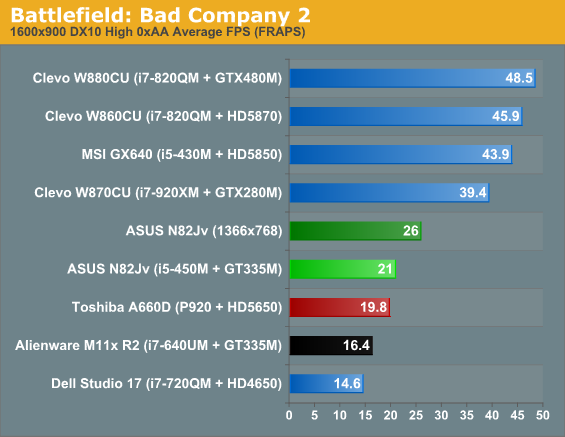
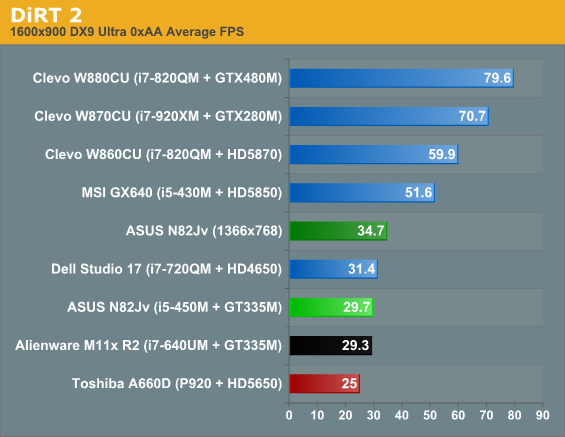
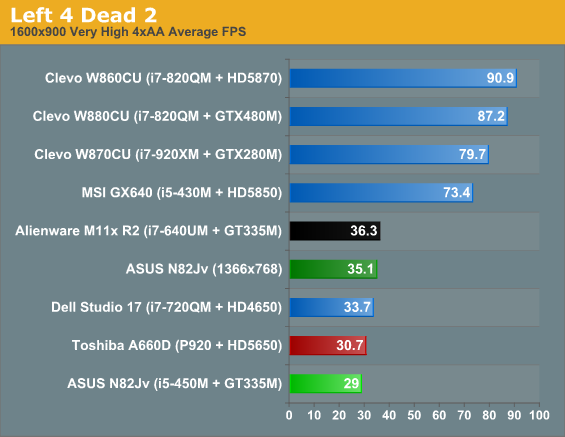
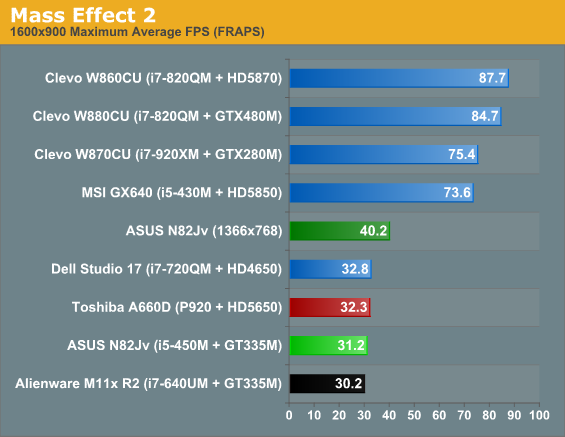

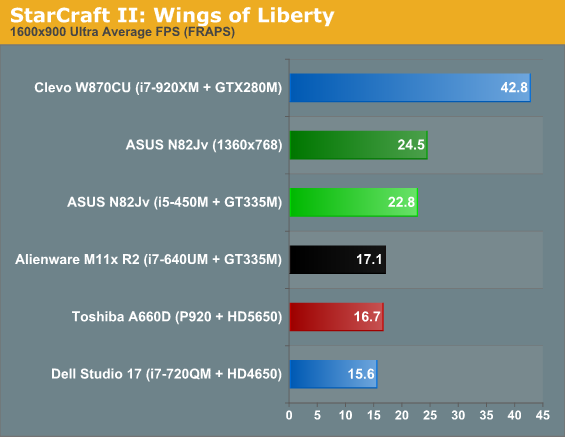
At our "High" settings and native 768p resolution, the N82Jv still manages to post nearly playable results in most of the games, with only BFBC2 and SC2 falling below the 30FPS threshold. However, there's a huge gap between the GT 335M and the high-end GPUs like the 280M, HD 5850/5870, and 480M. All of those turn in average frame rates that are more than twice as fast as the GT 335M at 900p. What we're really interested in seeing is where the new midrange 425M and 435M parts fall, particularly if they can hit the same price and power point as the 335M!
3DMark Performance
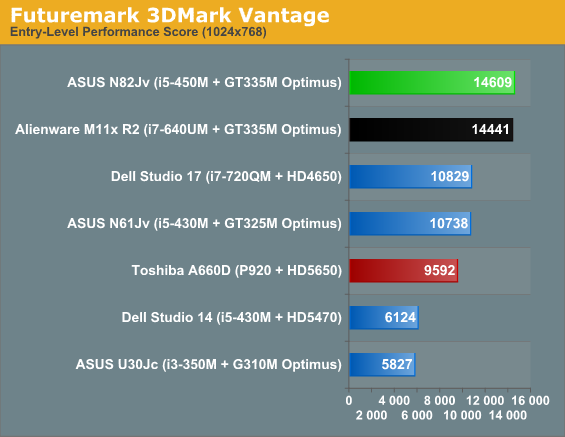
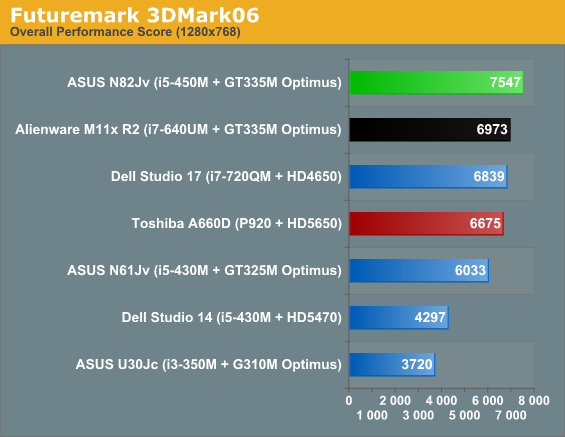
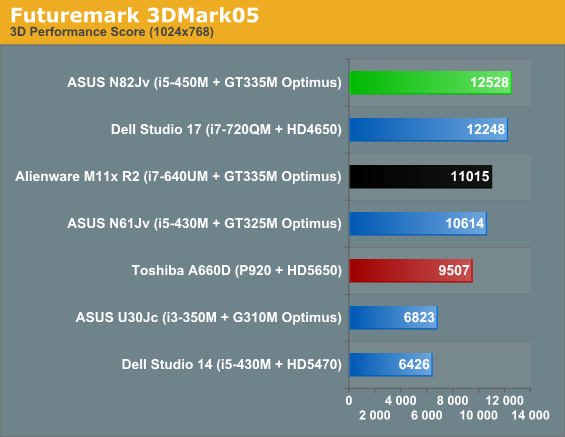
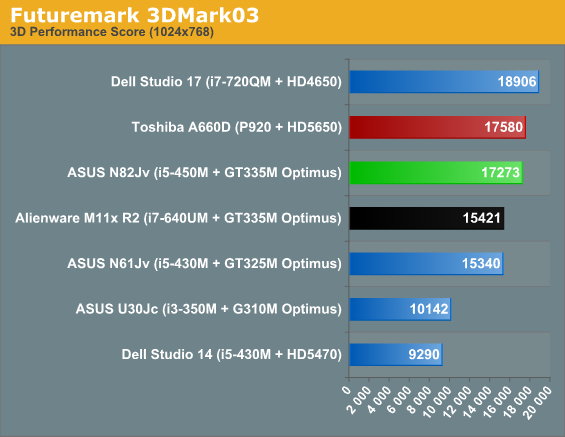
How about the ubiquitous 3DMark? We've saved this one for last, mostly because we don't consider it a replacement for gaming tests. The results are similar (in some cases) to our gaming tests, though margins are smaller relative to the M11x R2. 3DMark has always been more of a GPU rather than a CPU stress test, so seeing the two GT 335M systems score so similarly isn't a surprise. The gap between the N82Jv and the A660D on the other hand covers a wide range; it's a dead heat in 3DMark03, a 13% lead for the N82JV in 06, 32% in 05, and 52% in Vantage. Vantage does incorporate some CPU testing and PhysX into the mix, so that may explain the gap there, but obviously there's a lot going on that a single number doesn't properly disclose.










33 Comments
View All Comments
Hrel - Sunday, September 12, 2010 - link
GPU = DX10. Simply foolish to buy that as we near 2011Screen resolution = 1366x768. Seriously?! When will they learn?
Just a personal thing, but I'd prefer a 15" laptop just cause I want a numpad.
Asus if you're reading this:
Screen resolution of 1600x900 or greater. (Preferably a contrast ratio of 500:1 or higher)
Battery size of 60Wh or greater. (Preferably 84Wh)
GPU = Nvidia DX11 with similar performance to the AMD HD5650.
CPU = Intel dual core w/ HT @2Ghz or greater with 3MB L3 cache or greater.
HDD = 7200rpm 320GB or greater. (500GB Seagate MomentusXT hyrbrid drive would be best.)
Don't price it over $1000. Go over to cyberpower.com, they build a similar system to this on a Compal whitebox for under 1K.
Hrel - Sunday, September 12, 2010 - link
you know, even if they stuck with the "standard" quality screen but upped the resolution I'd be happy. Just offer an upgrade to a better screen for 100 bucks or so. The batter can't give though, anything under 60Wh is ridiculous.Hrel - Sunday, September 12, 2010 - link
Just to clarify the GPU choice, I'm totally ok running games at 1280x720 on my laptop. High end all "eye candy" on gaming is what my desktop is for. That doesn't mean it's ok to make the screen low resolution. 1600x900 or higher or I won't even look at it.JarredWalton - Sunday, September 12, 2010 - link
Yeah, but you can't do 1600x900 gaming I think is the rationale. Or something. I got this laptop a couple weeks back, before the DX11 400M announcement, which arguably steals some of the thunder as well. I just really hope the inevitable update can give us the bigger battery, better screen, and at least a 435M. That would be a very sweet laptop, and it shouldn't be hard to take the N82Jv and make those tweaks in less than a month. Sell off the low-end screen in other models and make a nice "N82 Pro".kmmatney - Sunday, September 12, 2010 - link
The 16:9 display was the worst thing to ever happen to laptops...beginner99 - Sunday, September 12, 2010 - link
this.16:9 is bascially only useful for games and movies. for browsing or office work it's a pain in the ass. even 16:10 can be annoying for that.
teohhanhui - Wednesday, September 15, 2010 - link
I find 16:10 to be perfect for side-by-side comparison or just for viewing 2 pages of a document at a time.FH123 - Sunday, September 12, 2010 - link
Screen resolution = 1366x768. Seriously?! When will they learn?This comment scares me. Am I the only one who doesn't value resolution highly? I've used Windows 7 and still found plenty of software not fully optimised for high DPI, so I'd rather stick to the above resolution. I'd simply want a good display in that resolution.
I am the owner of a Thinkpad T410s with a 1440x900 display. Better, right? At least still 16:10? Wrong! Contrast ratio 95:1, black-level 2.9 cd/m2. I've no doubt the Asus' screen is crap, like Jarred says, but there's worse to be found in the high-end business segment. Basically I think I'd kill for the Asus' screen at twice the contrast and 1/3 the black-level!
synaesthetic - Sunday, September 12, 2010 - link
Windows 7 is designed for a minimum vertical pixel count of 768, so really, 1366x768 should only be present on laptops in the sub-13" size category.This is how I see it...
There's just no point in robbing yourself of more vertical pixels. And fix the "standard netbook resolution" of 1024x600 to actually be 16:10 instead of 16:9.4 or whatever it actually is.
1366x768 is a stupid resolution and deserves to go away.
10": 1024x640
11-12": 1280x800
13-14": 1600x900
15": 1600x900 or 1920x1200
16" and up: 1920x1200
Accept no substitutes.
synaesthetic - Sunday, September 12, 2010 - link
Correction: 15" should be 1680x1050 or 1920x1200 depending on preference. 1600x900 is the only good 16:9 resolution IMO, and it's pretty much perfect on a 14" panel.